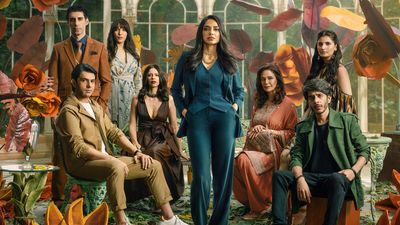Last week’s Amazon Prime Video drop Made in Heaven Season 2 has a scene where a middle-class character, Jazz (played by Shivani Raghuvanshi), speaks of her office: “You can’t do fashion here”. It is such a great moment, almost as if she is addressing the show’s makers themselves. Take us seriously, don’t just dress us up. And yet, it is the dresses that speak louder than the stories. After all, this is India, where the lehenga matters more than the wedding, perhaps even the groom.
This is not a complaint though. We are watching cinema in a country where escapism is de rigueur. Whether our movie theatres are plush multiplexes or dusty, rexine-seated standalones, we need to forget our daily drudgery for those three hours. Thus, the difference between mainstream and art-house is in whether you want a mirror to reality or to be rescued from it.
The new medium that has taken over India’s storytelling in the last few years—OTT platforms such as Netflix and Disney+ Hotstar—faces the same binary. On the one hand we see shows and films that bring to the fore those faces and stories that would have otherwise not been told. On the other, there is the acknowledgement that one is creating for those with laptops and cell phones now, an Instagram generation that is not too bothered with authenticity and originality, so long as it makes for pretty pictures.
So, Made in Heaven Season 2 “does fashion”. It does it like we have never before seen fashion being done in cinema. And that is really a very good thing.
Indian films have long had stylists and costume designers dressing up the characters in designer clothing. More so in the last two decades. But MiH2 had more designer labels in it than India Fashion Week. And not once did it look forced or overwhelming. Instead, it looked exalted and effortless. And for that, the impossibly chic stylist Bhawna Sharma needs to be commended. Sharma, the former supermodel-turned-sometime stylist, splits her time between Barcelona and Mumbai.
All the brides of MiH2 are dressed in wedding wear from the best bridal designers in the country: Sabyasachi Mukherjee, Tarun Tahiliani, Manish Malhotra, Raw Mango, Gaurang Shah, Gaurav Gupta, Rimple and Harpreet, Gauri and Nainika, and Aisha Rao. Each of these pieces were especially created for the show. Even the families’ outfits are matched for colour and design language to make for better portraits.
Shobhita Dhulipala’s Tara Khanna is decked in Raw Mango, Torani, Kshitij Jalori, Amit Aggarwal, and AMPM saris, and outfits by Bodice and Roma Narsinghani, too. Raghuvanshi and Mona Singh wear Jigar Mali; Arjun Mathur wears Antar Agni; Trinetra Haldar Gummaraju wears Aseem Kapoor; Shashank Arora wears Rishta by Arjun Saluja; and Jim Sarbh and Kalki Koechlin show off their richer-than-thou status by wearing Bulgari and Christian Louboutin.
Dhulipala’s Tara is a much stronger woman this season, and her wardrobe shows power suits and cinched waists. Raghuvanshi’s Jazz has a more chic wardrobe this time, with more tastefully elevated high street pieces.
Dressing characters in real-time glamour is an underrated challenge. Somehow period films offer that temporal distance, a little nostalgia and historic appeal. But when characters are to be dressed like you and me, making the film’s styling a hero by itself is even more of a challenge. Films like Band Baaja Baraat, Dil Dhadakne Do and Gehraiyaan get it right. As does MiH2, where a character, Kabir, says of marriage, but which holds true for seamlessly stylish films, too: “It doesn’t matter if they are true or not, it is an ideal the world needs.”


